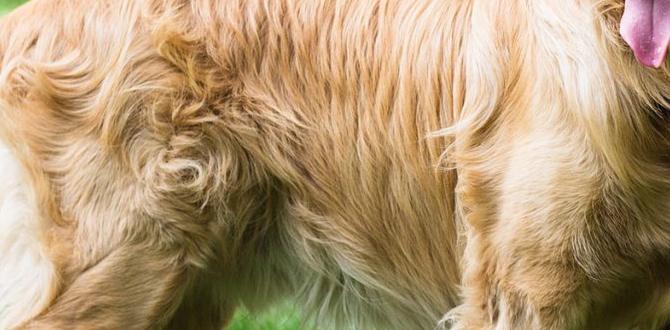Have you ever come home to find your dog anxious and upset? Many people face this problem. Dogs can feel very lonely when their owners leave. This feeling is known as separation distress. It can make both dogs and their owners very unhappy.
Imagine leaving your furry friend at home only to return to a mess. Your shoes are chewed, and they might be barking loudly. This is not just a naughty dog. It’s a cry for help. Understanding this can really change how we treat our pets.
Fixing dog’s separation distress isn’t as hard as it might seem. With a few simple changes, you can help your dog feel safe and happy when alone. Are you ready to learn how? Let’s explore some fun and effective ways to ease your dog’s worries and help them relax.
Fixing Dog’S Separation Distress: Effective Solutions And Tips Separation Distress In Dogs Is A Common Issue That Can Lead To Destructive Behaviors And Emotional Turmoil For Both Pets And Their Owners. Understanding How To Effectively Address And Alleviate This Concern Is Crucial In Fostering A Happy And Secure Environment For Your Canine Companion. In This Article, We Will Explore Several Strategies To Help You In Fixing Your Dog’S Separation Distress. Understanding Separation Distress Separation Distress, Often Mistaken For Generalized Anxiety, Manifests When A Dog Becomes Overly Attached To Its Owner. This Attachment Can Lead To Signs Of Distress When Left Alone, Including Barking, Whining, Or Even Destructive Behavior. Recognizing The Signs Early On Can Mitigate Long-Term Behavioral Issues. Identifying The Causes Before Attempting To Fix Your Dog’S Separation Distress, It’S Essential To Identify Potential Triggers. These Can Range From Early Separation From The Litter To Major Life Changes Such As Moving Homes Or The Loss Of A Family Member. Understanding What Causes Your Dog’S Anxiety Will Help Tailor An Effective Approach. Gradual Desensitization One Effective Method For Fixing Your Dog’S Separation Distress Is Gradual Desensitization. This Technique Involves Slowly Getting Your Dog Accustomed To Being Alone For Short Periods And Gradually Increasing The Duration. Start By Leaving The Room For Just A Few Minutes And Returning Before Your Dog Has A Chance To Get Anxious. Over Time, Increase The Duration As Your Pet Becomes More Comfortable. Creating A Safe Space Designating A Safe, Comfortable Space Where Your Dog Can Retreat When You’Re Away Can Help Alleviate Separation Distress. This Area Should Be Equipped With Their Favorite Toys, A Cozy Bed, And Some Items That Smell Like You. Familiar Scents Can Provide Comfort And Reduce Anxiety. Engaging Activities Providing Your Dog With Engaging Activities Can Distract Them From Feelings Of Loneliness. Puzzle Toys Filled With Treats, Chew Toys, Or Interactive Games Can Keep Your Pet Occupied While You Are Away. Regular Exercise Is Also Essential, As A Tired Dog Is Less Likely To Experience Anxiety. Training And Commands Basic Training Can Significantly Reduce Separation Distress. Teaching Your Dog Commands Like Stay Or Lie Down Can Instill A Sense Of Discipline And Predictability. Incorporating Positive Reinforcement Techniques, Such As Treats And Praise, Will Help Strengthen Your Dog’S Trust And Confidence. Professional Help If Your Efforts At Fixing Your Dog’S Separation Distress Are Ineffective, Seeking The Help Of A Professional Dog Trainer Or Behaviorist May Be Necessary. These Experts Can Provide Personalized Guidance And More Advanced Strategies To Address The Issue. Conclusion Fixing Dog’S Separation Distress Is A Process That Requires Patience, Consistency, And Understanding. By Identifying The Causes, Employing Strategic Techniques, And Offering Continual Support, You Can Help Your Dog Feel Secure And Relaxed When Left Alone.

Fixing Dog’s Separation Distress
Separation distress in dogs can be tough for both pets and owners. It makes your dog anxious when you leave. Do you notice your furry friend barking or acting out? This behavior signals that they need help. Effective strategies include creating a calm environment and gradually increasing alone time. Fun fact: some dogs find comfort in toys that stimulate them. With patience and consistent training, you can help your dog feel safe and relaxed when you’re not home.Understanding Separation Distress in Dogs
Definition and symptoms of separation distress. Common triggers and causes of the condition.Separation distress is when dogs feel really sad or anxious when left alone. Symptoms include barking, whining, or even chewing on furniture. Common triggers can be sudden changes, like moving to a new home or a family member leaving. Think of it as their version of losing their favorite chew toy! The good news is there are ways to help them feel better.
| Symptoms | Common Triggers |
|---|---|
| Barking or whining | Moving to a new home |
| Destructive behavior | Pets left alone for long periods |
| Pacing or hiding | Changes in the household |
Understanding these signs can help you help your furry friend. Remember, every pup is different, and they just want to feel loved—even if that means you have to show them where the good toys are!
The Science Behind Canine Separation Anxiety
How dogs develop separation anxiety. The role of genetics and early socialization.Dogs can develop separation anxiety for several reasons. It often begins during puppyhood. If a puppy does not experience positive interactions with different people, places, and other pets, they may feel scared when left alone. Genetics also play a part. Some breeds are more prone to anxiety, like Chihuahuas and Border Collies. It’s a bit like needing a security blanket—some dogs just need it more than others!
| Factor | Effect |
|---|---|
| Genetics | Some dogs are naturally more anxious. |
| Early Socialization | Puppies who aren’t socialized properly may struggle with being alone. |
In short, a mix of genes and early experiences shapes a dog’s comfort with being alone. It’s like figuring out if a kid is a natural introvert—some just need a little extra love!
Identifying the Signs of Separation Distress
Behavioral indicators to watch for when left alone. Differences between separation anxiety and normal behaviors.Dogs can be quite the drama queens! When left alone, they may show signs that they are not okay. Watch for behaviors like barking, whining, or even chewing your favorite shoes. These signs are clues that your pup might be feeling anxious.
Normal behaviors include sniffing or exploring, while separation anxiety is more intense and persistent. Observe your dog: Does he drool excessively or try to escape? These can be big red flags!
| Behavior | Meaning |
|---|---|
| Barking or Whining | May signal distress |
| Chewing Household Items | Tendency to cope with anxiety |
| Hiding or Seeking Attention | Signs of discomfort |
By knowing these behaviors, you can help your dog relax. Remember, anxiety is no joke, but understanding your furry friend can lighten the mood!
Preparing Your Dog for Alone Time
Creating a comfortable environment for your dog. Gradual desensitization techniques to ease anxiety.Leaving your dog alone can be tough for both of you. Start by creating a cozy spot for your furry friend. Add their favorite blanket and a toy. Make it feel like a mini doggy paradise! Next, try short absences. Leave your dog alone for just a few minutes each day. Gradually increase this time. This helps them get used to being alone without losing their cool. Remember, it’s all about practice, patience, and maybe a treat or two!
| Technique | Description |
|---|---|
| Comfort Zone | Set up a safe space with a blanket and toys. |
| Short Goodbyes | Leave for a few minutes, then come back. |
| Gradual Increase | Slowly extend the time apart. |
Using these techniques will help your pup feel like a superstar, even when you’re away! As they say, “Every dog has his day!” Just make sure yours don’t spend too much time wondering where you went.
Training Techniques to Alleviate Distress
Positive reinforcement and rewardbased training. Importance of routine and structured departure practices.Using training techniques can help your dog feel better when you leave. Positive reinforcement is key. It means giving treats or praise when your dog stays calm. This teaches them that being alone is okay. Stick to a routine, too! Dogs love knowing what to expect. For example, have a special goodbye ritual. This makes them feel safe.
- Offer treats for calm behavior.
- Practice short separations to build confidence.
- Use a consistent departure routine.
How can I help my dog with separation distress?
Provide regular exercise and mental stimulation. Keeping them busy can reduce anxiety and make them feel less alone.
Behavioral Modification Strategies
The role of crate training in alleviating separation anxiety. Using toys and distractions effectively.Crate training helps your dog feel safe when you leave. It creates a cozy space where they can relax. This can ease anxious feelings. Toys and other distractions can also help. Try giving your dog a favorite toy or a puzzle. These keep them busy while you are gone. They will learn to enjoy their alone time. You can even use calming music. All these things help reduce your dog’s stress.
What can help a dog with separation anxiety?
Crate training, toys, and distractions are key solutions. They create a positive experience when your dog is alone. You might also consider leaving an item with your scent to provide comfort.
Effective Distractions:
- Fun toys to chew on
- Interactive puzzles
- Calming music or sounds
Alternative Solutions and Support
The use of calming products and tools, such as pheromone diffusers. Benefits of pet daycare and alternative companionship during the day.Sometimes, calming products can transform a nervous dog into a relaxed buddy. Pheromone diffusers release soothing scents that help them chill. Imagine a little spa for your pup right at home!
Pet daycare is another great option. It’s like a playdate every day! Your dog can make furry friends while you’re at work, easing their loneliness. They learn and have fun, and you get peace of mind.
| Solution | Benefits |
|---|---|
| Pheromone Diffusers | Promotes relaxation. |
| Pet Daycare | Reduces loneliness and boredom. |
So, whether it’s a calming scent or a doggy playgroup, there are fun ways to help your furry friend feel happy and secure!
Case Studies and Success Stories
Reallife examples of overcoming separation distress. Lessons learned and tips from successful pet owners.Dogs can be drama queens when their owners leave! A few pet owners found clever ways to soothe their furry friends. For example, one dog owner used a stuffed toy that squeaked like a dog. Bingo! The pup thought he had a buddy to play with. Another owner created a fun routine—leaving a tasty treat right before leaving! This distracted the dog and made them feel special. These clever tricks taught us that a little fun and planning can help. Here’s a quick look at their success:
| Owner | Method | Result |
|---|---|---|
| Jane | Stuffed toy | Happy pup, less barking |
| Tom | Treat routine | Excited, calm dog |
Learn from these stories! Creativity and a sprinkle of fun can work wonders for calming your furry friend’s nerves.
Conclusion
In conclusion, fixing your dog’s separation distress takes time and patience. Start by making departures and arrivals calm. Use positive reinforcement to reward your dog when they stay relaxed. Practice short separations to help them adjust. We can help our furry friends feel safe and happy. For more tips, check out training books or websites focused on dog care.FAQs
What Are The Common Signs Of Separation Distress In Dogs, And How Can I Identify Them In My Pet?Common signs of separation distress in dogs include barking, whimpering, or howling when you’re gone. You might notice your dog pacing or trying to follow you around the house. Some dogs may chew on things or go to the bathroom inside the house. If your dog is overly clingy when you are home, that can be a sign too. Pay attention to these behaviors, and you’ll understand how your dog feels when you leave.
What Training Techniques Can Be Used To Help A Dog Become More Comfortable With Being Alone?To help your dog feel better when alone, we can start with short absences. Leave your dog for just a few minutes. Gradually make the time longer. Provide toys or treats to distract them. You can also create a cozy space where they feel safe. With practice, your dog will learn that being alone is okay.
Are There Specific Tools Or Products, Such As Anxiety Wraps Or Pheromone Diffusers, That Can Aid In Alleviating A Dog’S Separation Distress?Yes, there are tools that can help dogs with separation anxiety. An anxiety wrap is like a snug jacket that makes dogs feel safe. Pheromone diffusers spread calm scents that relax dogs. You can also try toys that keep them busy when you are away. These products can make a big difference!
How Can I Create A Positive Environment For My Dog To Reduce Anxiety When I Leave The House?To help your dog feel safe when you leave, create a cozy space with their bed and favorite toys. You can give them a special treat or a toy that keeps them busy. Try playing calming music to make the place feel more relaxed. Also, practice leaving for short times so your dog gets used to it. Always give them lots of love and pets when you say goodbye!
When Should I Consider Seeking Professional Help For My Dog’S Separation Distress, And What Types Of Specialists Are Best Suited For This Issue?You should think about getting help if your dog is very upset when you leave. Signs include barking, chewing, or going to the bathroom inside. If these problems go on for a while, it’s good to ask for help. You can see a dog trainer or a vet who understands behavior issues. They can give you ideas to help your dog feel better.
Meet Elyse Colburn, the devoted canine companion and storyteller behind the enchanting world of “Tales, Tails, and Adventures Unleashed.” A passionate dog enthusiast with a heart full of paw prints, Elyse Colburn shares heartwarming tales and insightful adventures, celebrating the joy, loyalty, and endless antics that make every dog a true hero. Join Elyse Colburn on this tail-wagging journey, where every post is a love letter to our four-legged friends.







